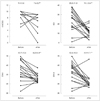Abstract
Objectives
The purpose of this study is investigate the clinical characteristics and the change of depression and anxiety in pathological gamblers who completed 10-week admission treatment programs.
Methods
To investigate the clinical characteristics, we included 40 pathological gamblers who completed admission treatment programs from Jan 2006 to Jun 2010. To measure the change through treatment, we included 16 patients who completed pre-treatment and post-treatment assessment scales, including the Korean-National Opinion Research Center DSM-IV Screen for Gambling Problems (K-NODS), Beck's Depression Inventory (BDI), and the State-trait Anxiety Inventory (STAI), from May 2008 to Aug 2008.
Results
Mean age of the patients was 42.9±9.0 years and mean intelligent quotient was 109.7±10.4. Thirty (75%) patients showed comorbid disorders, including depression (14 patients, 35%), anxiety disorder (five patients, 12.5%), alcohol use disorder (five patients, 12.5%), and personality disorder (four patients, 10%). After treatment, K-NODS, BDI, STAI-I, and STAI-II scores showed improvement, from 9.1±1.5 to 7.6±2.7, from 23.5±5.8 to 11.1±3.2, from 52.6±10.3 to 41.9±7.1, and from 53.7±10.6 to 46.0±4.4, respectively.
Figures and Tables
 | Fig. 1Change of gambling problems, depression and anxiety after treatment in the pathological gamblers. Measurements are shown as mean±SD and paired t-test was used for statistical analysis of changes before and after the treatment (*: p<0.05, **: p< 0.01). K-NODS : Korean-National Opinion Research Center DSM-IV Screen for Gambling Problems, BDI : Beck's Depression Inventory, STAI : State-Trait Anxiety Inventory, DSM-IV : Diagnostic and Statistical Manual of Mental Disorders, fourth edition, SD : Standard deviation. |
References
1. American Psychiatric Association. Diagnostic and Statistical Manual of Mental Disorders. 2000. 4th ed. Text Revision. Washington, DC: American Psychiatric Association;671.
2. Petry NM, Ammerman Y, Bohl J, Doersch A, Gay H, Kadden R, et al. Cognitive-behavioral therapy for pathological gamblers. J Consult Clin Psychol. 2006. 74:555–567.

4. Lowengrub K, Iancu I, Aizer A, Kotler M, Dannon PN. Pharmacotherapy of pathological gambling: review of new treatment modalities. Expert Rev Neurother. 2006. 6:1845–1851.

5. Dannon P, Sason M, Shalgi B, Tusan L, Sapir Y, Kotler M. [Comorbid psychiatric symptoms in pathological gamblers: anxiety, depression and substance abuse]. Harefuah. 2004. 143:643–646. 695
6. Lorains FK, Cowlishaw S, Thomas SA. Prevalence of comorbid disorders in problem and pathological gambling: systematic review and meta-analysis of population surveys. Addiction. 2011. 106:490–498.

7. Kessler RC, Hwang I, LaBrie R, Petukhova M, Sampson NA, Winters KC, et al. DSM-IV pathological gambling in the National Comorbidity Survey Replication. Psychol Med. 2008. 38:1351–1360.

8. Hodgins DC, Peden N, Cassidy E. The association between comorbidity and outcome in pathological gambling: a prospective follow-up of recent quitters. J Gambl Stud. 2005. 21:255–271.

9. Ladouceur R, Sylvain C, Sévigny S, Poirier L, Brisson L, Dias C, et al. Pathological gamblers: inpatients' versus outpatients' characteristics. J Gambl Stud. 2006. 22:443–450.

10. Breen RB, Kruedelbach NG, Walker HI. Cognitive changes in pathological gamblers following a 28-day inpatient program. Psychol Addict Behav. 2001. 15:246–248.

11. Jung SY, Son DS, Choi YS, Shin HH, Kim SH, Choi YS, et al. A study on the development and effectiveness of social-psychological rehabilitation program for gamblers. Ment Health Soc Work. 2009. 32:285–320.
12. Yeom TH, Park YS, Oh KJ, Kim JG, Lee YH. K-WAIS Guidlines. 1992. Seoul: Korea Guidance.
13. Kim JS, Han KH, Lim JY, Lee JH, Min BB, Moon KJ. MMPI-2 manual. 2005. Seoul: Mamumsarang.
14. Derogatis LR. SCL-90-R: Administration, scoring, and procedures manual. 1994. Minneapolis, MN: National Computer Systems, Inc..
15. Min BB, Oh HS, Lee JY. TCI manual. 2007. Seoul: Maumsarang.
16. Kim KH. Reliability and validity of Korean NODS. Korean J Health Psychol. 2003. 8:487–509.
17. Lee YH, Song JY. A study of the reliability and the validity of the BDI, SDS, and MMPI-D Scales. Korean J Clin Psychol. 1991. 10:98–113.
18. Kim JT. 1978. Seoul: Korea University.
19. Suurvali H, Cordingley J, Hodgins DC, Cunningham J. Barriers to seeking help for gambling problems: a review of the empirical literature. J Gambl Stud. 2009. 25:407–424.

20. Ledgerwood DM, Orr ES, Kaploun KA, Milosevic A, Frisch GR, Rupcich N, et al. Executive function in pathological gamblers and healthy controls. J Gambl Stud. 2012. 28:89–103.

21. Moravec JD, Munley PH. Psychological test findings on pathological gamblers in treatment. Int J Addict. 1983. 18:1003–1009.

22. Graham JR. MMPI-2: Assessing personality and psychopathology. 2006. 4th ed. New York: Oxford University Press.
23. Han YO, Kim HW, Kim TW, Lee JG, Jeong JY. The characteristics of male pathological gamblers based on MMPI-2 profiles. Korean J Clin Psychol. 2011. 30:519–536.

24. Shin YC. The Temperament and Character Dimensions in Pathological Gambling Patients. 2002. Seoul: Chung-Ang University.
25. Petry NM, Stinson FS, Grant BF. Comorbidity of DSM-IV pathological gambling and other psychiatric disorders: results from the National Epidemiologic Survey on Alcohol and Related Conditions. J Clin Psychiatry. 2005. 66:564–574.





 PDF
PDF ePub
ePub Citation
Citation Print
Print




 XML Download
XML Download